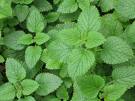Herb uses - Peppermint, Mentha x piperita
Mentha x.piperita Lamiaceae/Labiatae The peppermint we know today isáa perenma cultivated as a cross between water mint and spearmint,áit has square, purplish or crimson stems and its aromatic leaves are oval shaped but with pointed tips.The plant bears crimson whorls if flowers in late summer. Parts used
ConstituentsPeppermint is rich in phenolic compounds (7 per cent), whose properties include antiviral, antiinflammatory and antioxidant actions. It also contains generous amounts of flavonoids and tannins. The yield of essential oil is extremely high - 10-30ml a kg of the dried plant. The oil's composition varies according to the weather and when it is harvested. The oil's main constituents are menthol (30-50 per cent), menthone (15-35 per cent) and menthyl acetate (10 per cent). CAUTIONS
PREPARATION AND DOSAGEFor internal use TO TREAT bloating, sluggish digestion, belching, flatulence, inadequate bile secretion INFUSION Put 1 dessertspoon of dried leaves into 150ml of boiling water. Leave to infuse for 10-15 minutes. Strain. Drink 1 cup after meals. FOR A TONIC EFFECT Take 2 cups after meals.FOR A SEDATIVE EFFECT Take1 cup in the evening. For external use TO TREAT colds, oral infections INHALATIONS, MOUTH WASHES Put a handful of leaves into a bowl of boiling hot water. Inhale the steam or cool and use as a mouthwash. TO TREAT skin disorders ESSENTIAL OIL Dilute, allowing 3 drops to 10ml of carrier oil. Apply to the affected area. IF SYMPTOMS PERSIST CONSULT A DOCTOR Medicinal usesPeppermint has antispasmodic, digestive properties due mainly to its essential oil and flavonoids. It is therefore taken internally to treat problems such as bloating, sluggish digestion, belching, flatulence and inadequate bile secretion.A clinical trial performed in Taiwan in 1997 verified its carminative effect when peppermint oil was found to relieve the intestinal cramps suffered by individuals with irritable bowel syndrome (185). In 2001 American researchers also found it to be effective in children with 185. In small doses it has a sedative effect and a tonic effect in large doses. Externally the essential oil helps to soothe skin irritations and insect bites. Taken as an inhalation, it is useful in the treatment of colds and flu since the menthol component acts as a nasal decongestant. It can also be used as a mouthwash to treat oral infections and is believed to remedy headaches. Commercially, the largest use of peppermint oil is in the flavouring of chewing gum. CultivationSuited to rich, moist soil. Place in a sunny or lightly shaded location. |
´╗┐
Ayurveda Book
This book on Ayurveda is meant for people interested to know about basics concepts of Ayurvedic healing and learn ayurveda concepts. Though there are many books Read More My SitesReal Testimonials
Connect with us |







